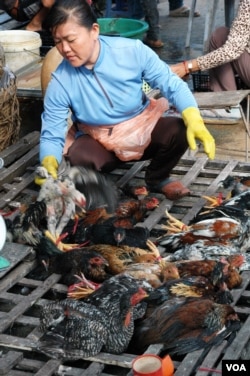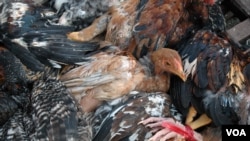PHNOM PENH —
Health officials are scheduled to meet in the Cambodian capital on Monday, March 24, to discuss that country’s increase in the number of cases of avian influenza in humans. The most recent victim, a two-year-old girl, died on March 14, bringing the number of confirmed fatalities this year to four. Fourteen Cambodians died last year from the H5N1 strain of avian influenza, more than half of the global total.
At the Chhbar Ampov market, one of Phnom Penh’s largest, sales of chickens are going well. Ly Mey has been slaughtering birds for a decade. She kills, plucks and sell about 20 a day.
She buys them from Prey Veng, a province that lies between Phnom Penh and neighboring Vietnam, and which is a hotspot for the H5N1 strain of avian influenza. But Ly Mey is not concerned about the disease.
She says it is easy to tell immediately, and better than the veterinarian, whether a chicken is healthy.
It is a similar story elsewhere in the market: Chum Sophal, who sells 100 kilograms of chicken legs and wings daily, is under the mistaken impression that live birds do not carry avian influenza.
She says the chickens she buys are safe because they were alive at the time. She says buyers of meat from her chickens should not worry because she does not sell meat from chickens already dead.
Both women are wrong. Chickens can carry H5N1 before showing any signs, while infected ducks often do not show any sign of infection at all. The risk for humans comes when handling infected birds or eating them without cooking them properly. In those circumstances, humans can contract H5N1. The fatality rate in people whom testing showed were infected with H5N1 is around 60 percent.
Need to change behaviors
The women’s lack of understanding is no great surprise. Since H5N1 was first detected here in poultry in January 2004, the authorities and donors have tried to get people to change their behavior when handling birds. Experts say that effort has largely failed.
That is partly because some 80 percent of the country’s 20 million chickens and ducks are raised in close proximity to humans. The U.N.’s Food and Agriculture Organization, or FAO, believes H5N1 is endemic in Cambodia’s poultry.
However, the government will not pay compensation to villagers who lose their poultry to the disease. As a consequence, when birds fall ill, the incentive for impoverished villagers is either to sell them or to eat them - not to report the outbreak.
The FAO’s Lotfi Allal says prevention efforts should try to focus on further measures to ensure early reporting of the virus.
“The virus is here, is circulating. We have to be aware, not making a panic, and we have continue working closely together with the human sector to see how better we can do to reduce the risk for humans and how early we can detect the virus [which] has its source in the poultry,” said Allal.
With 18 fatalities from H5N1 over the past 15 months, Cambodia has reported the worst statistics of any country in the world. More than half of Cambodia’s 56 confirmed cases of H5N1 infection in humans to date have occurred since the start of last year.
Human-to-human transmission
The main concern of health experts is that H5N1 will mutate to allow human-to-human transmission.
Most of Cambodia’s cases of H5N1 have been in the country’s southeast, an area that shares a porous border with Vietnam through which birds are smuggled with few inspections. But where Cambodia reported more than 30 cases in humans since the start of 2013, Vietnam reported just four.
Speaking via Skype, Dr. Dennis Carroll, who heads the pandemic influenza and other emerging threats unit at USAID - the U.S. government’s development arm - says that is puzzling because the H5N1 variant is the same on both sides of the border.
“The epidemiology, the genetics, of both the virus and the presentation both in poultry and in humans are pretty much shared. But we’re seeing a huge inequity between what’s showing up on the Cambodia side versus what’s showing up on the Vietnam side without any real obvious explanation,” said Carroll.
There are several possibilities for the increase in human infections in Cambodia. It could be due to better monitoring and reporting, or it could be there really are more infections, or it could be some combination of the two.
At this stage, the experts simply do not know, which is why USAID is hosting Monday’s meeting with officials from Vietnam and Cambodia, in part to improve information-sharing and responses to outbreaks.
Cambodia already has built a much-improved surveillance and testing program for H5N1. But it still has no poultry vaccination program nor a plan to compensate farmers who cull their birds. Experts say that if the situation worsens, that might have to change.
At the Chhbar Ampov market, one of Phnom Penh’s largest, sales of chickens are going well. Ly Mey has been slaughtering birds for a decade. She kills, plucks and sell about 20 a day.
She buys them from Prey Veng, a province that lies between Phnom Penh and neighboring Vietnam, and which is a hotspot for the H5N1 strain of avian influenza. But Ly Mey is not concerned about the disease.
She says it is easy to tell immediately, and better than the veterinarian, whether a chicken is healthy.
It is a similar story elsewhere in the market: Chum Sophal, who sells 100 kilograms of chicken legs and wings daily, is under the mistaken impression that live birds do not carry avian influenza.
She says the chickens she buys are safe because they were alive at the time. She says buyers of meat from her chickens should not worry because she does not sell meat from chickens already dead.
Both women are wrong. Chickens can carry H5N1 before showing any signs, while infected ducks often do not show any sign of infection at all. The risk for humans comes when handling infected birds or eating them without cooking them properly. In those circumstances, humans can contract H5N1. The fatality rate in people whom testing showed were infected with H5N1 is around 60 percent.
Need to change behaviors
The women’s lack of understanding is no great surprise. Since H5N1 was first detected here in poultry in January 2004, the authorities and donors have tried to get people to change their behavior when handling birds. Experts say that effort has largely failed.
That is partly because some 80 percent of the country’s 20 million chickens and ducks are raised in close proximity to humans. The U.N.’s Food and Agriculture Organization, or FAO, believes H5N1 is endemic in Cambodia’s poultry.
However, the government will not pay compensation to villagers who lose their poultry to the disease. As a consequence, when birds fall ill, the incentive for impoverished villagers is either to sell them or to eat them - not to report the outbreak.
The FAO’s Lotfi Allal says prevention efforts should try to focus on further measures to ensure early reporting of the virus.
“The virus is here, is circulating. We have to be aware, not making a panic, and we have continue working closely together with the human sector to see how better we can do to reduce the risk for humans and how early we can detect the virus [which] has its source in the poultry,” said Allal.
With 18 fatalities from H5N1 over the past 15 months, Cambodia has reported the worst statistics of any country in the world. More than half of Cambodia’s 56 confirmed cases of H5N1 infection in humans to date have occurred since the start of last year.
Human-to-human transmission
The main concern of health experts is that H5N1 will mutate to allow human-to-human transmission.
Most of Cambodia’s cases of H5N1 have been in the country’s southeast, an area that shares a porous border with Vietnam through which birds are smuggled with few inspections. But where Cambodia reported more than 30 cases in humans since the start of 2013, Vietnam reported just four.
Speaking via Skype, Dr. Dennis Carroll, who heads the pandemic influenza and other emerging threats unit at USAID - the U.S. government’s development arm - says that is puzzling because the H5N1 variant is the same on both sides of the border.
“The epidemiology, the genetics, of both the virus and the presentation both in poultry and in humans are pretty much shared. But we’re seeing a huge inequity between what’s showing up on the Cambodia side versus what’s showing up on the Vietnam side without any real obvious explanation,” said Carroll.
There are several possibilities for the increase in human infections in Cambodia. It could be due to better monitoring and reporting, or it could be there really are more infections, or it could be some combination of the two.
At this stage, the experts simply do not know, which is why USAID is hosting Monday’s meeting with officials from Vietnam and Cambodia, in part to improve information-sharing and responses to outbreaks.
Cambodia already has built a much-improved surveillance and testing program for H5N1. But it still has no poultry vaccination program nor a plan to compensate farmers who cull their birds. Experts say that if the situation worsens, that might have to change.









